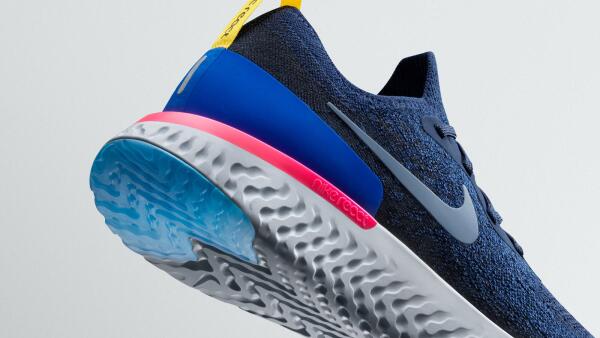Nike's Epic React Shoe Could Be 'The Holy Grail for Cushy Shoes', Here's What We Know So Far
Nike is releasing the Nike Epic React Flyknit next month but the new Nike React foam that will be used in the shoe has everyone talking since they announced it this morning.
Everyone is talking about it.
Co.Design called it "flubber for your feet", Runner's World says it could be "the holy grail for cushy shoes", and HighSnobiety says it "could be a serious challenger" to adidas' Boost" foam.
Whatever monicker you want to call it, one thing is for certain, it's going to be a big deal.
We tried out the new #nikereact running shoe today. Stay tuned for a full review and launch recap 👟 pic.twitter.com/nMbI8QBCn5
— Chicago Athlete Mag (@ChicagoAthlete) January 23, 2018
Nike unveils the new Epic React running shoe https://t.co/fF0V1Sj08w pic.twitter.com/v2KEv0ImVI
— USA TODAY Money (@USATODAYmoney) January 23, 2018
The Nike React technology isn't new, it's been used in two basketball shoes, the Nike React Hyperdunk 2017 and the Jordan Super.Fly 2017
Nike React foam cushioning launched in June 2017 in basketball — a sport that requires players to shift direction and speed in seamless motion and to lift off at the blink of an eye. The foam met those needs by providing a sensation that is as soft and springy as it is squishy and stable.
After more than 400 hundred combinations of chemistry and processing, and using scientific methods to dial in on materials with certain amenable attributes, they landed the unique composition of Nike React foam.
Because the runners expressed that they craved similar sensations, it was a no-brainer to take Nike React technology to running shoes.
The shoe's upper is minimal and takes cues from popular past models.
The shoe’s upper is simple. The forefoot, toe and arch are very sculpted thanks to the one-piece Nike Flyknit bootie (think similar to the Nike Flyknit Racer or Nike LunarEpic) that was precision-engineered for support, flexibility and breathability in the spots where runners need it. It’s minimal and close to the foot but still supportive.

But that's where the minimalism stops.
In 2009, Chris McDougal published a book called Born to Run, which challenged what was historically accepted about running shoes and instigated the barefoot or minimalist movement. Just three years later in 2012, Valerie Bezdek’s class-action lawsuit against Vibram Five-Fingers for deceptive advertising was the loud thud that marked the end of the minimalist running movement. The running community quickly returned to shoes with more padding. And so did Nike.
The foam alone delivers 13 percent greater energy return than Nike’s latest generation of Nike Lunarlon foam.
“I want to emphasize this because we’re not comparing Nike React technology to some no-name foam that fell off the back of a truck somewhere; we’re comparing it to our latest Lunarlon and, even with the bar set that high, Nike React technology delivers that much more energy return with each and every stride,” says Ernest Kim, Director of Advanced Footwear, Nike Running.
Wondering what that feels like? Well, if you were to squeeze Nike React foam, you’d get an obvious cushioning sensation; and then, as you let go, you’d see the foam quickly spring back to its original shape, which is where the energy return comes into play. That translates so well to a run because as it reacts swiftly to each step, bouncing back to its original state to ensure a consistent underfoot feel stride after stride, mile after mile.

Nike React technology is Nike’s longest-lasting foam.
Because the upper sits on one piece of foam, the outsole is essentially the same as the midsole, but with a segment of rubber under the forefoot and heel to help enhance the shoe's durability. “Nike React is more durable than any other foam we’ve tested in Nike running, meaning it will keep up with the needs of even the most dedicated distance runners,” says Kim.
A lot of science went into this foam.
React was the product of Nike’s own innovation lab, and the result of over 400 attempts of mixing new materials at a factory in Taiwan, shaping them and cooking them in ovens, then testing these bricks of foam before actually molding them into a shoe and trying them on.
Computational design, which enables rapid data-driven ideation, was used to create the midsole, which is one piece of Nike React foam (with no carrier, cement or glue). This method allowed for engineering the surface of the midsole to deliver cushioning and support in the specific spots needed during a run, while eliminating material wherever it’s not absolutely necessary in order to keep weight to a minimum. The visually complex pattern varies in depth, where deeper parts indicate areas of more cushioning and shallower portions produce more firmness.
Runners are loving them.
Elite and everyday runners tested Nike React technology in more than 17,000 miles of running, which converts to more than 27,300 kilometers. “Over that span, our wear-testers consistently told us that Nike React made them want to run more often,” says Kim. “My favorite bit of feedback came from a wear tester who said of running in the Nike Epic React: ‘It felt fun — it makes you want to run.’”
Look for the Nike Epic React Flyknit to be at Fleet Feet Sports Chicago stores on February 22nd.
Connect With Us
see the latest from Fleet Feet Chicago